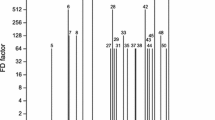Abstract
The potent odorants of four olive oil samples differing in flavor were quantitated, and their odor activity values (OAVs) were calculated by dividing the concentrations of the odorants in the oil samples by the flavor threshold values in the oil. The odorants with higher OAVs were contrasted with the different notes of the flavor profiles of the olive oils. It was concluded that the following compounds contributed mainly to the flavor notes given in parentheses: (Z)-3-hexenal (green), ethyl 2-methylbutyrate, ethyl isobutyrate, ethyl cyclohexanoate (fruity), (Z)-2-nonenal (fatty) and 4-methoxy-2-methyl-2-butanethiol (black-currant-like). The results showed that the calculation of OAVs is an approach to objectify the flavor differences of olive oil samples.
Similar content being viewed by others
References
Guth, H., and W. Grosch,Fat Sci. Technol. 93:335 (1991).
Ullrich, F. and W. Grosch,Z. Lebensm. Unters. Forsch. 184:277 (1987).
Grosch, W.,Trends Food Sci. Technol. 4:68 (1993).
Schieberle, P., and W. Grosch,J. Agric. Food Chem. 35:252 (1987).
Guth, H., and W. Grosch,Lebensm. Wiss. Technol. 23:513 (1990).
Schieberle, P., and W. Grosch,Z. Lebensm. Unters. Forsch 192:130 (1991).
Gilbert, J., inApplications of Mass Spectrometry in Food Science, edited by J. Gilbert, Elsevier Applied Science, London, 1987, p. 89.
Esterbauer, H.,Fette Seifen Anstrichm 70:1 (1968).
Guth, H., and W. Grosch,Fat Sci. Technol. 91:225 (1989).
Sen, A., G. Laskawy, P. Schieberle and W. Grosch,J. Agric. Food Chem. 39:757 (1991).
Ullrich, F., and W. Grosch,J. Am. Oil Chem. Soc. 65:1313 (1988).
Ullrich, F., and W. Grosch,Fat Sci. Technol. 90:332 (1988).
Schieberle, P.,Z. Lebensm. Unters. Forsch. 193:558 (1991).
Schieberle, P., and W. Grosch,J. Agric. Food Chem. 36:797 (1988).
Meijboom, P.W.,J. Am. Oil Chem. Soc. 41:326 (1964).
Meijboom, P.W., and G.A. Jongenotter, Ibid.:680 (1981).
Rigaud, J., P. Etiévant, R. Henry and A. Latrasse,Sci. Aliments 6:213 (1986).
Author information
Authors and Affiliations
About this article
Cite this article
Guth, H., Grosch, W. Quantitation of potent odorants of virgin olive oil by stable-isotope dilution assays. J Am Oil Chem Soc 70, 513–518 (1993). https://doi.org/10.1007/BF02542586
Received:
Accepted:
Issue Date:
DOI: https://doi.org/10.1007/BF02542586




